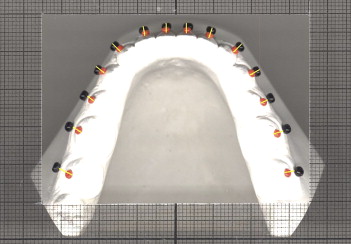Introduction
The aims of this study were to evaluate the distances between the mandibular permanent teeth and the alveolar process in Brazilians with normal occlusion and to compare them with normal American values.
Methods
We used 59 mandibular casts from untreated subjects who had permanent dentition and the 6 keys to normal occlusion. A computer program was used to calculate the distances between the dental reference points and the alveolar process for each tooth. The mean values were then compared to the normal values by applying the Student t test at a significance level of 0.05.
Results
The results showed a progressive increase of these distances from the anterior region (incisors) to the posterior region (molars), from 0.00 to 2.49 mm. All measurements had statistically significant differences from the American sample, except for the values for canines and first premolars.
Conclusions
Brazilians with normal occlusion have more lingual crown positions for the incisors, second premolars, and molars compared with Americans with normal occlusion. Although these findings were statistically significant, they are unlikely to be clinically significant.
Editor’s summary
In the effort to achieve greater posttreatment stability, wouldn’t it be useful to know how mandibular teeth relate to the mandible in subjects with normal occlusion? The authors of this study believed that a manner to determine that relationship was by measuring the distances between the dental crowns (FA points) and the alveolar bone (WALA ridge). Once known, it should be possible to idealize the archwire shape to place the teeth on the center of the alveolar bone ridge and over supporting basal bone. A recent study showed a positive correlation between the FA points and WALA ridge, and concluded that this information might be useful as a guide for individualized archwire design.
Fifty-nine mandibular dental casts of Brazilian subjects, ages 12 to 21 years, were selected from the files of a postgraduate orthodontic department in São Paulo, Brazil, because they presented with the 6 keys to normal occlusion as defined by Andrews. You will want to read the online article to fully understand the methods and the mean measurements for the distances of each permanent tooth, from the mandibular central incisors to the second molars. The findings showed more lingual positions of the mandibular teeth in Brazilians with normal occlusion than in a sample of white subjects with normal occlusion in the study by Andrews and Andrews. These differences were small and not clinically significant. The discrepancy between the mean values of the FA points and WALA ridge distances in this study and the results of other authors might be attributed to different methodologies and differences in their samples.





